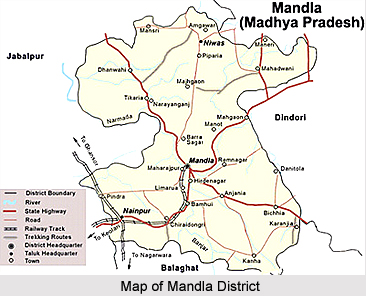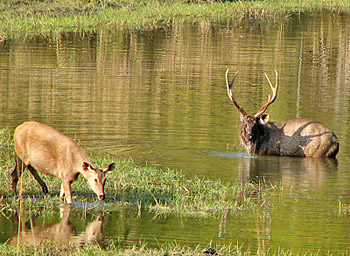 Mandla District is one of the dominated districts in Madhya Pradesh. The district lies almost entirely in the catchments of Narmada River and its tributaries. Mandla District is located in the east-central part of Madhya Pradesh. It forms the eastern part of the Jabalpur District. Mandla District forms a part of Satpura mountain range, which separates the cotton growing southern region from the wheat growing extension of the Malwa Plateau on the north, and is the watershed of three district river systems. There are 9 development blocks, 4 tehsils and 1247 villages in the district.
Mandla District is one of the dominated districts in Madhya Pradesh. The district lies almost entirely in the catchments of Narmada River and its tributaries. Mandla District is located in the east-central part of Madhya Pradesh. It forms the eastern part of the Jabalpur District. Mandla District forms a part of Satpura mountain range, which separates the cotton growing southern region from the wheat growing extension of the Malwa Plateau on the north, and is the watershed of three district river systems. There are 9 development blocks, 4 tehsils and 1247 villages in the district.
History of Mandla District
History of the Mandla District suggests that this district derives its name from the headquarters town, Mandla. The three traditions about the name "Mandla" are more or less prevalent in the area. Indian Puranic details relate "Mandla" to the Sanskrit word `Mandal` meaning a circle; because River Narmada almost girdles the town on three sides. According to another view, the real name of Mandla is said to have been `Mahish-mandal`, or `Mahishmati` of ancient Sanskrit literature. Some scholars identify it with Mahismati, which is said to have been one of the ancient seats of the Haihaya princes. The original name might have been Mahishmati-Mandla, of Mahes-Mandla, which has now become simply Mandla. The third view of the probable origin of the name `Mandla` is probably a distortion of the word `Mandal` or feudatory division of the kingdom of the Kalachuris of Tripuri.
Geography of Mandla District
Mandla District lies between the latitude 22 degree 2 minutes and 23 degree 22 minutes north and longitude 80 degree 18 minutes and 81 degree 50 minutes east. The Tropic of Cancer thus passes through the north of this district. The total area covered by Mandla District is 13,269 sq kilometres. Thus before bifurcation it was the sixth largest district in the state. Its extreme length is about 133 km from north to south and extreme breadth 182 kilometres from east to west.
The landform of Mandla is rugged. It is quite difficult to describe the comparison of the district with any geometrical figure. However, it tends to assume a scorpion like appearance. The district is bounded on the north-west by Jabalpur district; on the north and north-east by Shahdol district; on the south-east by Bilaspur District -Rajnandgaon district; on the south by Durg District and Balaghat district and on the west by Seoni district. To the north of Mandla, on either side of Mandla-Jabalpur road, is a large, rugged and inaccessible tract, containing between them two pockets of the richest block soil, round about Narayanpur and Lakhanpur. Narmada River is the main river flowing through the district. It has several tributaries that are flowing through the region. In comparison with the low-lying plains of Jabalpur and Raipur District on the north and south, the climate of Mandla District is cool and exhilarating. Quartz, mica, manganese, bauxite, limestone, clay, Fuller`s earth, iron and dolomite are the main minerals found in the district.
Demography of Mandla District
 According to the Population Census in India in the year 2011, Mandla District had population of 1,053,522. Out of which the males and female were 525,495 and 528,027 respectively. The population of Mandla District constituted 1.45 percent of total population of Madhya Pradesh. The population density of Mandla district is 182 people per sq. km. The Mandla district administers 5,800 square kilometres of areas. The average literacy rate of Mandla was 68.28 percent. The male and female literacy rates were 79.49 and 57.20 percent respectively. The total literates in Mandla District were 620,481. Out of which the male and female literates were 359,137 and 261,344 respectively.
According to the Population Census in India in the year 2011, Mandla District had population of 1,053,522. Out of which the males and female were 525,495 and 528,027 respectively. The population of Mandla District constituted 1.45 percent of total population of Madhya Pradesh. The population density of Mandla district is 182 people per sq. km. The Mandla district administers 5,800 square kilometres of areas. The average literacy rate of Mandla was 68.28 percent. The male and female literacy rates were 79.49 and 57.20 percent respectively. The total literates in Mandla District were 620,481. Out of which the male and female literates were 359,137 and 261,344 respectively.
Culture of Mandla District
The Gond Tribe and Baiga tribe are the main tribal groups of Mandla District. Thus, it can be said that the culture of Mandla District is mainly tribal in nature. Traditional folk dances and folk songs constitute an important part of the culture of Mandla District. Hareli Festival, Khyania, Melamadai, Nawa Feast and Bidri ceremony are some of the major festivals of the region.
Economy of Mandla District
The economy of Mandla District relies mainly on forests and other natural resources like the timber and as well as tourism in this district. Kanha Tiger Reserve is one of the Mandla`s most famous tourist attraction sites.
Tourism in Mandla District
The Kanha National Park is located in the Mandla district. This National Park is one of the most tourist attractive sites for both the domestic as well as foreign tourists. Kanha becomes a land of Royal Bengal Tiger, a home for more than 100 tigers. The area of Kanha Tiger Reserve is 1945 square. Kilometres. Kanha is a destination for wildlife visitors from all over the world for its pride the Royal Bengal Tigers and other animals.
This Reserve is governed under the Wildlife Protection Act of 1972 and the reserve rules. The "Project Tiger in India" is one of the largest Tiger conservation schemes in the world. It was launched in India in 1973 with the objectives to ensure the maintenance of a viable population of the tiger in India. It has also the objective to preserve, for all times, such areas as park of our national heritage for the benefit, education and enjoyment of future generations. Kanha was among the first nine tiger reserves included in the "Project Tiger Network" in 1973. Kanha has fame itself by bringing back from an imminent extinction the Central Indian Swamp Deer also called Barasingha. There are only 66 specimens of the sub-species were left in 1970. Scientific management and strict monitoring has recovered the population to around 330 specimens. In Kanha National Park, there are some other animals found like Chital or Spotted deer, Sambhar, Barasingha, Barking deer, Chousingha, Gaur, Langur, Wild pig, Jackal, Sloth bear and Wild dog. There are around 260 species of birds identified there. The Birds like Peafowl, Jungle fowl, pained spur fowl, grey partridges, Painted Partridges, Indian roller, Racket tailed drongo, Red wattled lapwing, Yellow wattled lapwing.






